"This car is a tank!", How many times have we heard or used this "association" of words, perhaps in reference to our old-fashioned fueled car or with no more brilliant performance.
It will be just a "tank" the subject of this article, although "armed" does not properly have the characteristics of the collective imagination, in fact lacks the "Cannon". We could better define it as a means of protection during advancements in conflict areas.
You will have understood that we are about to talk about the most popular tracked vehicle whose design dates back to the late 40s and early 50s. It's about the wagon M113 A, that tracked and amphibious vehicle from 11 tons assembled with aluminum alloys from 35 millimeters and used to transport infantry teams composed of 13 military. Its operational definition is Moutain Biking (Truppa Transport Vehicle).
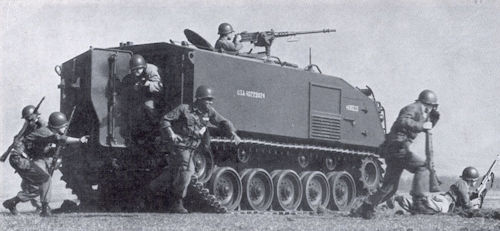 Produced initially by FMC, Food Machinery Corporation of Philadelphia, the revolutionary M113 had to offer superior characteristics to its predecessor M59 (picture on the right) that, even for the excessive weight, did not have a great military success.
Produced initially by FMC, Food Machinery Corporation of Philadelphia, the revolutionary M113 had to offer superior characteristics to its predecessor M59 (picture on the right) that, even for the excessive weight, did not have a great military success.
The association between M113 A and the "American cars" years' 60-'70 is in itself very realistic, just remember some films where US cars accelerated all over gas Route 66 producing the same noise as our M113. During an exercise in the 90s with the artillery in Lonate Pozzolo, I remember very well having associated the powerful noise of the M113 tank with the car noise overseas. The Leopards, on the other hand, produced a sort of whistle coming from the turbines rather than from their 10 cylinders.
Maybe just listen to the "sound" emitted by a Harley Davidson engine to clarify the concept.
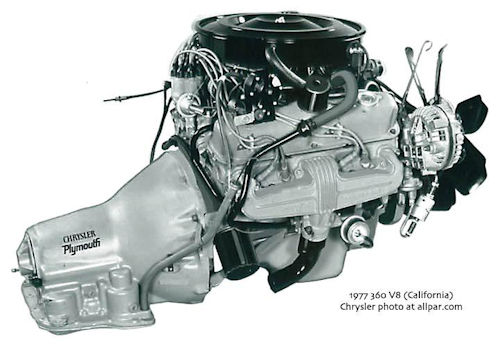 The engine
The engine
It is the same engine-mounted engine, for example on the Chrysler New Yorker models of the 1960, a 7.500 with 8 cylinders and with 4 valves but with only 215 horses, which favor the torque rather than - as you can imagine - the power. In the years 80, in the USA the ridiculous costs of petrol and the dimensions and masses of vehicles, required to build engines that were opposed to the European concept and perhaps more similar as performance to large diesel engines rather than petrol engines.
Our "armored" was updated through the following series A, A2 and A3; a new General Motors engine was associated with 6 cylinders but a diesel engine, produced for the Italian and European markets, by our OTO Melara under American license. The horses did not change, but the fuel consumed by gasoline ranged around the 2 liters per kilometer (you understand well ...) allowing little more than 380 miles of autonomy. Its speed is, however, 70 km / h.
Good power-to-weight ratio, though now exceeded but comparable to trucks - international category N2 - with 12 ton. of course.
How it looks
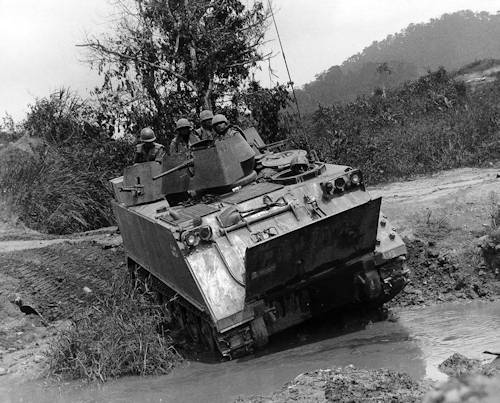 A parallelepiped with two tracks on the sides of the hull and an inclined front surface toward the direction of travel. The top has 3 openings, two of which are "stickers"; one for the driver riding the stand and the other turning for the commander on which you can attach a Browning machine gun or a cannon turret in defense and coverage of the military 10 transported maybe before landing in the operating theater. To these two openings, a door for entry or evacuation is added, while on the back there is a double opening with a door inserted into a hydraulic platform that, when opened, reveals the entire rear side.
A parallelepiped with two tracks on the sides of the hull and an inclined front surface toward the direction of travel. The top has 3 openings, two of which are "stickers"; one for the driver riding the stand and the other turning for the commander on which you can attach a Browning machine gun or a cannon turret in defense and coverage of the military 10 transported maybe before landing in the operating theater. To these two openings, a door for entry or evacuation is added, while on the back there is a double opening with a door inserted into a hydraulic platform that, when opened, reveals the entire rear side.
Restyling A, A2 and A3 had all the essential features imposed by US Defense. The former, in addition to relatively low weight and amphibious (but not floating) use, were the certainty of a watertight closure that also had the purpose of safeguarding military occupants of chemical attacks. The armored vehicle, however, has a forced and recirculating and air suction system with special filters.
The M113 can wade in depths of just less than its height at speeds of about 6 km / h, however, the rivers must not have a speed higher than 3 meters per second in order not to compromise the maneuverability of the vehicle. The beveled front has a reclining surface that runs from cutwater during the advance and prevents the water from going up the upper "bridge" entering the hatches.
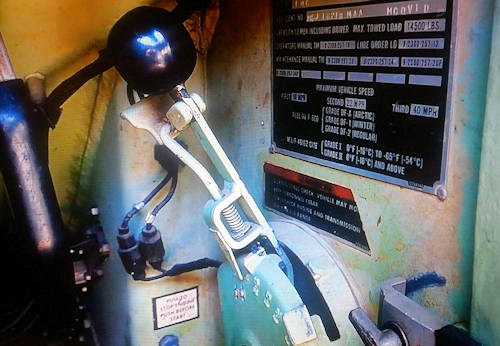
How does the transmission occur?
If the US car engine was associated with a THM automatic transmission, Transmission Hydra Matic - standard on all models - on the M113 was assembled a similar product system however from Allison with initially 4 gears past due to 6. In fact, Allison still produces automatic gearboxes and heavy duty vehicle transmission systems. In torque converters, the rotating engine movement is hydraulically transmitted with the classic "red oil" and the two "immersed" rotors (called seed drills) assume a hydraulic pump feature and the other of the receiving turbine. Being a slightly dated vehicle, the VTT does not have the converter block exclusion, which would favor transmission ratio, engine brake and fuel consumption.
The operation at the gearbox output is interesting and at the same time ingenious; In fact, the transmission unit is positioned and protected on the front right of the chassis and here the transmission is fed to a common differential which is double to T on the axle shafts, designed to bring traction to the toothed wheels on the first front axle. On both sides of the axles, two epicyclic gears are placed (what we have called in other articles torque distributor). 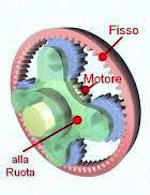 In fact it is a differential in line, that is, a system that allows the same axis two different speeds also acting as a reducer. The guide conductor has two levers in front of it that when pulled they act on 2 belt brakes, slowing or blocking the surface of the satellite impeller of the epicline to be restrained. This system allows (in general) to steer a crawler vehicle to make it rotate on itself or to keep it restrained with the engine running idle and engaging gear. In fact, the automatic hydraulic changes in use on heavy vehicles, by virtue of their mass, do not have the position of Park, which acts with a mechanical arpionism system; this is because with the massive masses of the vehicles, it would be easy to break through making useless gearbox and vehicle. Parking is achieved with the gear lever in position Neutral and maneuvering levers pulled. The same maneuver that is performed on automatic line buses or automatic ATTL. On board there are radio equipment, liquid drain pumps and oxygen cylinders.
In fact it is a differential in line, that is, a system that allows the same axis two different speeds also acting as a reducer. The guide conductor has two levers in front of it that when pulled they act on 2 belt brakes, slowing or blocking the surface of the satellite impeller of the epicline to be restrained. This system allows (in general) to steer a crawler vehicle to make it rotate on itself or to keep it restrained with the engine running idle and engaging gear. In fact, the automatic hydraulic changes in use on heavy vehicles, by virtue of their mass, do not have the position of Park, which acts with a mechanical arpionism system; this is because with the massive masses of the vehicles, it would be easy to break through making useless gearbox and vehicle. Parking is achieved with the gear lever in position Neutral and maneuvering levers pulled. The same maneuver that is performed on automatic line buses or automatic ATTL. On board there are radio equipment, liquid drain pumps and oxygen cylinders.

The start-up takes place after the electrical connection by pressing a red button on the instrument panel to the left of the driver, who has only the accelerator pedal and can choose to drive sitting looking at the armored crystals in front of him, or standing with his head out of the hatch. On the inner surface of the roof, to the right of the driver's seat there is a release lever for the opening of the rear hatch, which for closing, uses a hydraulic linkage controlled by the same lever. The engine can be accessed internally but a part of it can be accessed from the outside from the outside by removing the cover on the front flared area behind the navigation flap. The engine air filters, the hydraulic service containers and the tank are visible in the external "engine compartment".
From artillery batteries ...
Some graduates confided to me a technique similar to the electronic work of 'ASR, Anti Slip Regulation; in essence it is an "unofficial" technique born more from the malice learned in the manuals. It consists in operating the two brake levers giving gas to counteract braking on particularly slippery surfaces even for a crawler. In fact, even by inserting a fixed gear ratio, such as the second one, the pair of tracks may be excessive until they slip. With this system, you often have an advantage in difficult situations. A technique that is also used by trolley maneuvers during braking, in winter in the city on ice and wet tracks, as an alternative to emergency magnet discs (skates) that would cause a sudden and violent result.
fittings
 The chassis can have different outfits that favor it in the interventions compared to the half on rubber. One of these is healthcare, a kind of crawler ambulance that is very useful for the recovery of the wounded in areas of conflict where, despite international conventions, it is not uncommon for Sanity to undergo attacks by guerrillas.
The chassis can have different outfits that favor it in the interventions compared to the half on rubber. One of these is healthcare, a kind of crawler ambulance that is very useful for the recovery of the wounded in areas of conflict where, despite international conventions, it is not uncommon for Sanity to undergo attacks by guerrillas.
Civil protection jobs are not few, just remember the snowfall in Milan dell'85, where from the barracks Santa Barbara came out to the rescue of the City of Milan, several wagons of Voloire to break the ice with their weight and sweep the snow with the blade placed anteriorly.
Ballistic protection is limited to infantry weapons used in close conflicts.
Remember ...
At Lenta, a place in the Vercellias, as you will know, there is a field that rises amidst the huge rice fields, used for alienation parking for armored military vehicles. Here with some regret you can watch hundreds of Italian tanks including a lot of M113, abandoned and some dismantled. On the front and back surfaces, however, Stanag - Standardization Agreement - Glorious wards of our Army and Armed Forces, which, although faded by the years and the weather, are still alive in the hearts of thousands of citizens who served the country. Each of them is linked to indelible memories of military life, departments, stakes, but also friendships and experiences.

(photo: web)












